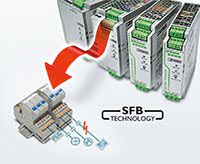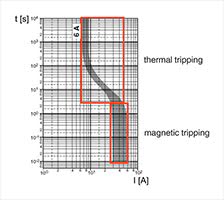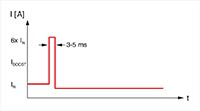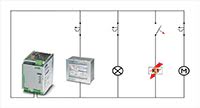Selective Fuse Breaking (SFB) Technology
Maximum System Availability
For maximum system availability, standard circuit breakers must be tripped magnetically to selectively switch off faulty current paths and ensure that important system parts continue operating without interruption. QUINT Power Supplies and DC/DC Converters, with SFB technology, will supply several times the nominal current for a short period to selectively trip miniature circuit breakers and fuses connected on the secondary side.
Your objective: maximum system availability
Faults can never be avoided completely in production. For example, short circuits in the wiring or load malfunctions may occur. Nevertheless, machines or systems located in unaffected areas should still continue operating without interruption.
The solution is to provide separate protection for the individual termination devices or smaller function groups. This prevents the unnecessary switch off of unaffected system parts in the event of an error.
QUINT Power Supplies and DC/DC Converters with SFB technology protect your production. SFB stands for selective fuse breaking. In the event of an error, the QUINT will supply up to six times the nominal current for 12 ms in order to switch off the affected circuit.
Cost-effective protection with circuit breakers
Usually additional loads, such as sensors or actuators, are connected to a power supply unit in parallel to the controller. To minimize downtimes, each of these current paths should be protected individually.
Therefore, if a short circuit occurs, only the faulty path of the power supply will be disconnected and the other loads will continue operating without interruption.
At present, standard circuit breakers represent the most cost-effective solution for protecting a circuit. They can be tripped electromagnetically or thermally via a bimetal.

To ensure that they trip within a few milliseconds, the current for the integrated solenoid must always be significantly higher than the nominal current of the circuit breaker.
Circuit breaker characteristics
The short-circuit currents required for electromagnetic tripping are usually specified for alternating current (AC) by manufacturers. Users must therefore make sure that the DC values are 1.2 times higher.
Circuit breakers are available with various tripping characteristics. Characteristic B or C circuit breakers are mostly used in industrial applications.
For characteristic B, the following currents are required in order to trip the circuit breaker:
- AC applications: three to five times the nominal current
- DC applications: three to six times the nominal current

Therefore, under the most unfavorable conditions, 150 A is required to trip a 25 A characteristic B circuit breaker within a few milliseconds.
For characteristic C circuit breakers, the following currents are required:
- AC applications: five to ten times the nominal current
- DC applications: five to twelve times the nominal current
SFB technology prevents voltage dips
In the event of an error, long cable paths limit the required tripping current. This can delay or even prevent circuit breakers being tripped.
If power supplies provide a lower power reserve, this means that thermal tripping may take several seconds or minutes.
In this case troubleshooting is very easy as you can see which circuit breaker has been tripped. However, during this time the 24 V DC voltage of the power supply has already been interrupted and the controller has failed.

In the worst-case scenario, the current supplied by the power supply unit is so low or it just supplies a brief power reserve of a few seconds meaning that the fuse is not even tripped. As a result troubleshooting is extremely time-consuming and expensive.
QUINT Power Supplies with SFB technology will supply up to six times the nominal current. The circuit breakers are tripped magnetically with this pulse.
Cable length and conductor cross section
Whether or not a circuit breaker is tripped fast enough also depends on the length and cross section of the cable via which a load is connected.
It is not just the amount of current that the power supply unit can supply which is crucial here. It is only if the impedance of the faulty current path is low enough that high current can also flow in the short circuit and trip the circuit breaker magnetically.

To determine which power supply is suitable for your application depending on the cable length and cross section, please refer to our configuration matrix at the bottom of this page.
Example scenario:
- A power supply (24 V/20 A) supplies a controller and three other loads.
- Each current path is protected by a circuit breaker (6 A/B characteristic).
- The current paths consist of 25 m long copper cables (2.5 mm² cross section).

In this example, in the event of a short circuit, the 20 A power supply unit supplies six times the nominal current for a short period using SFB technology, i.e., a maximum of 120 A. The circuit breaker is always tripped within 3 to 5 ms with ten times the rated current in the magnetic range of its characteristic curve.
The other loads continue operating, the controller is consistently supplied with 24 V DC and continues running without interruption in spite of the short circuit.
Device circuit breakers from Phoenix Contact
Phoenix Contact's range of thermomagnetic circuit breakers is the first to use the SFB characteristic curve.
This tripping characteristic has been specially developed for use with power supplies that operate on the basis of SFB technology. Combining these two devices ensures particularly reliable tripping in the event of an error, even in the case of long cables between the power supply and termination device.
The SFB characteristic curve is based on characteristic C but its tolerance has been narrowed considerably. The circuit breaker therefore reaches its tripping current faster and so is tripped sooner. This limits the short circuit current and reduces the load on cables and connected devices.

SFB Configuration Matrix
| Cable cross‐section | 0,75 mm² | 1,0 mm² | 1,5 mm² | 2,5 mm² | 4,0 mm² | 6,0 mm² | 10,0 mm² |
|---|---|---|---|---|---|---|---|
| 24V/5 A QUINT POWER with SFB Technology | |||||||
| Distance with standard circuit-breaker C2 | 5 m | 7 m | 11 m | 19 m | |||
| 24V/10 A QUINT POWER with SFB Technology | |||||||
| Distance with standard circuit-breaker C2 | 14 m | 19 m | 29 m | 49 m | |||
| Distance with standard circuit-breaker C4 | 4 m | 5 m | 8 m | 14 m | |||
| Distance with standard circuit-breaker B6 | 9 m | 12 m | 18 m | 30 m | |||
| 24V/20 A QUINT POWER with SFB Technology | |||||||
| Distance with standard circuit-breaker C2 | 14 m | 19 m | 29 m | 49 m | 79 m | <100 m | |
| Distance with standard circuit-breaker C4 | 8 m | 11 m | 17 m | 29 m | 47 m | 70 m | |
| Distance with standard circuit-breaker C6 | 4 m | 5 m | 8 m | 14 m | 22 m | 33 m | |
| Distance with standard circuit-breaker B6 | 12 m | 17 m | 25 m | 42 m | 68 m | < 100 m | |
| Distance with standard circuit-breaker B10 | 9 m | 13 m | 23 m | 37 m | 55 m | ||
| Distance with standard circuit-breaker B16 | 5 m | 9 m | 15 m | 22 m | |||
| 24V/40 A QUINT POWER with SFB Technology | |||||||
| Distance with standard circuit-breaker C2 | 14 m | 19 m | 29 m | 49 m | 79 m | < 100 m | < 150 m |
| Distance with standard circuit-breaker C4 | 8 m | 11 m | 17 m | 29 m | 47 m | 70 m | < 100 m |
| Distance with standard circuit-breaker C6 | 6 m | 8 m | 12 m | 20 m | 32 m | 48 m | 81 m |
| Distance with standard circuit-breaker C10 | 3 m | 5 m | 9 m | 14 m | 21 m | 36 m | |
| Distance with standard circuit-breaker C13 | 3 m | 5 m | 8 m | 13 m | 22 m | ||
| Distance with standard circuit-breaker B6 | 12 m | 17 m | 25 m | 42 m | 68 m | < 100 m | < 150 m |
| Distance with standard circuit-breaker B10 | 10 m | 16 m | 27 m | 43 m | 65 m | < 100 m | |
| Distance with standard circuit-breaker B16 | 8 m | 14 m | 23 m | 35 m | 58 m | ||
| Distance with standard circuit-breaker B20 | 9 m | 15 m | 23 m | 38 m | |||
| Distance with standard circuit-breaker B25 | 6 m | 10 m | 15 m | 25 m | |||
| 48V/5 A QUINT POWER with SFB Technology | |||||||
| Distance with standard circuit-breaker C2 | 17 m | 23 m | 35 m | 58 m | |||
| 48V/10 A QUINT POWER with SFB Technology | |||||||
| Distance with standard circuit-breaker C2 | 35 m | 47 m | 71 m | < 100 m | < 150 m | < 250 m | |
| Distance with standard circuit-breaker C4 | 10 m | 13 m | 20 m | 34 m | 54 m | 81 m | |
| Distance with standard circuit-breaker B6 | 19 m | 25 m | 38 m | 64 m | < 100 m | < 150 m | |
| 48V/20A QUINT POWER with SFB Technology | |||||||
| Distance with standard circuit-breaker C2 | 35 m | 47 m | 71 m | < 100 m | < 170 m | < 270 m | < 400 m |
| Distance with standard circuit-breaker C4 | 16 m | 21 m | 32 m | 54 m | 87 m | < 120 m | < 200 m |
| Distance with standard circuit-breaker C6 | 7 m | 10 m | 15 m | 25 m | 40 m | 61 m | < 100 m |
| Distance with standard circuit-breaker B2 | 76 m | 101 m | < 150 m | < 250 m | < 400 m | < 600 m | < 1000 m |
| Distance with standard circuit-breaker B4 | 40 m | 53 m | 80 m | < 120 m | < 200 m | < 300 m | < 500 m |
| Distance with standard circuit-breaker B6 | 26 m | 35 m | 53 m | 89 m | < 140 m | < 200 m | < 340 m |
| Distance with standard circuit-breaker B10 | 11 m | 15 m | 23 m | 39 m | 62 m | 94 m | < 150 m |